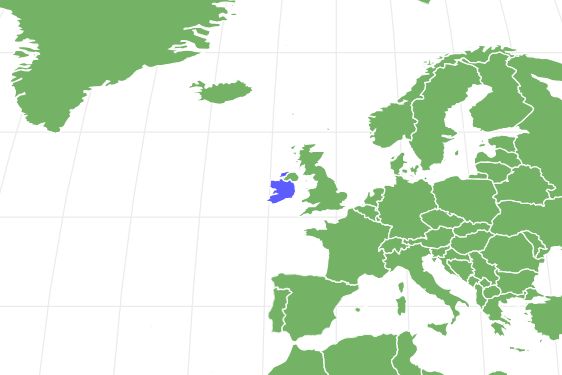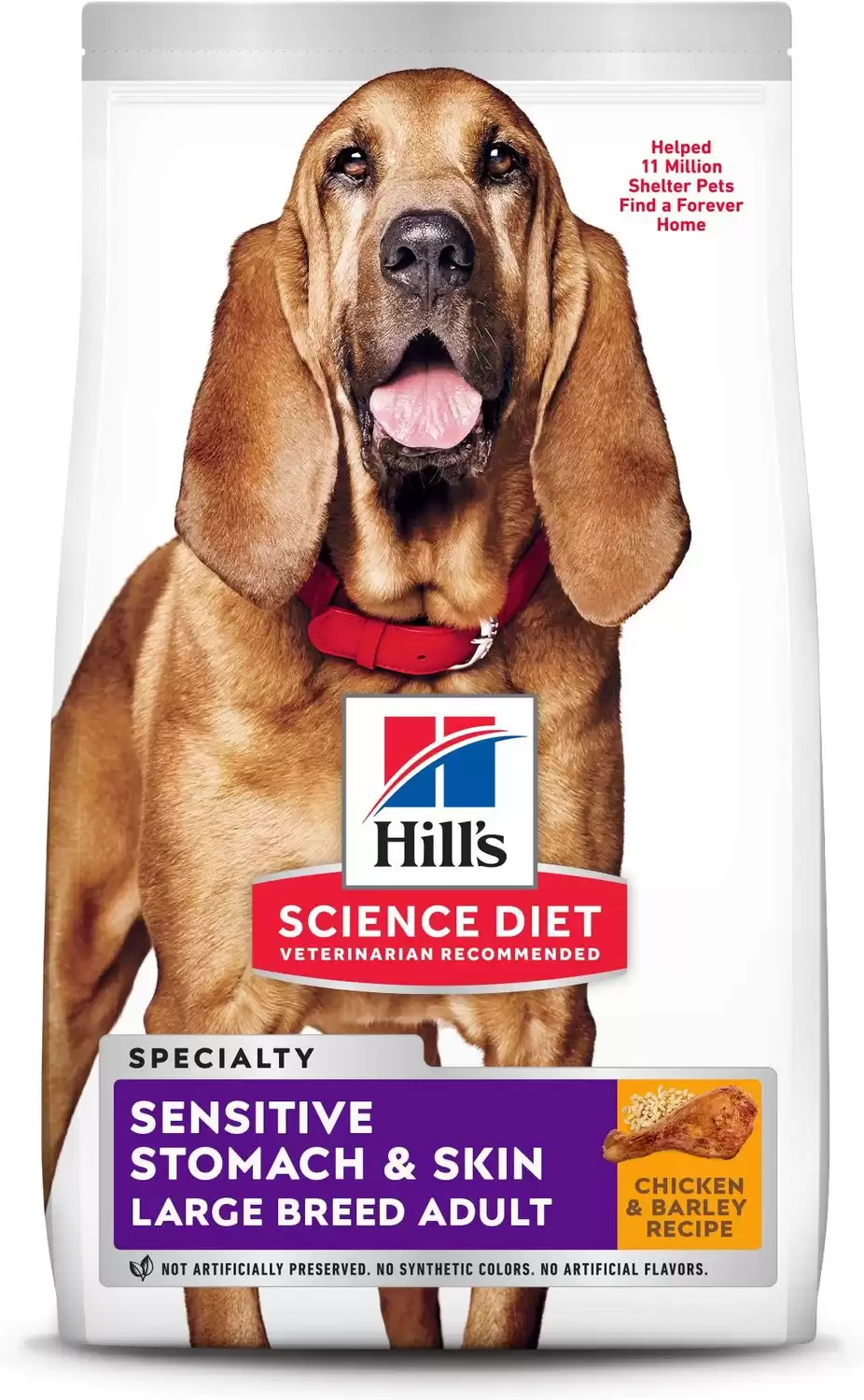Irish Setter
Canis Lupus
Has a beautiful coat that's flowing and feathered!
Advertisement
Irish Setter Scientific Classification
- Kingdom
- Animalia
- Phylum
- Chordata
- Class
- Mammalia
- Order
- Carnivora
- Family
- Canidae
- Genus
- Canis
- Scientific Name
- Canis Lupus
Read our Complete Guide to Classification of Animals.
Irish Setter Conservation Status
Irish Setter Facts
Irish Setter as a Pet:
- General Health
- Energy Level
- Shedability
- Trainability
- Intelligence
- Tendency to Chew
- Size
- Family and kid friendliness
- Yappiness / Barking
- Moderate
- Separation Anxiety
- Moderate
- Preferred Temperature
- Warm climate
- Exercise Needs
- High
- Friendly With Other Dogs
- High
- Pure bred cost to own
- $500 to $800
- Dog group
- Sporting
- Male weight
- 60-71 lbs
- Female weight
- 53-64 lbs
This post may contain affiliate links to our partners like Chewy, Amazon, and others. Purchasing through these helps us further the A-Z Animals mission to educate about the world's species.
View all of the Irish Setter images!
Irish setters are energetic, rambunctious dogs with a sweet temperament. They’re a favorite family dog because of their loyalty and fun-loving nature.
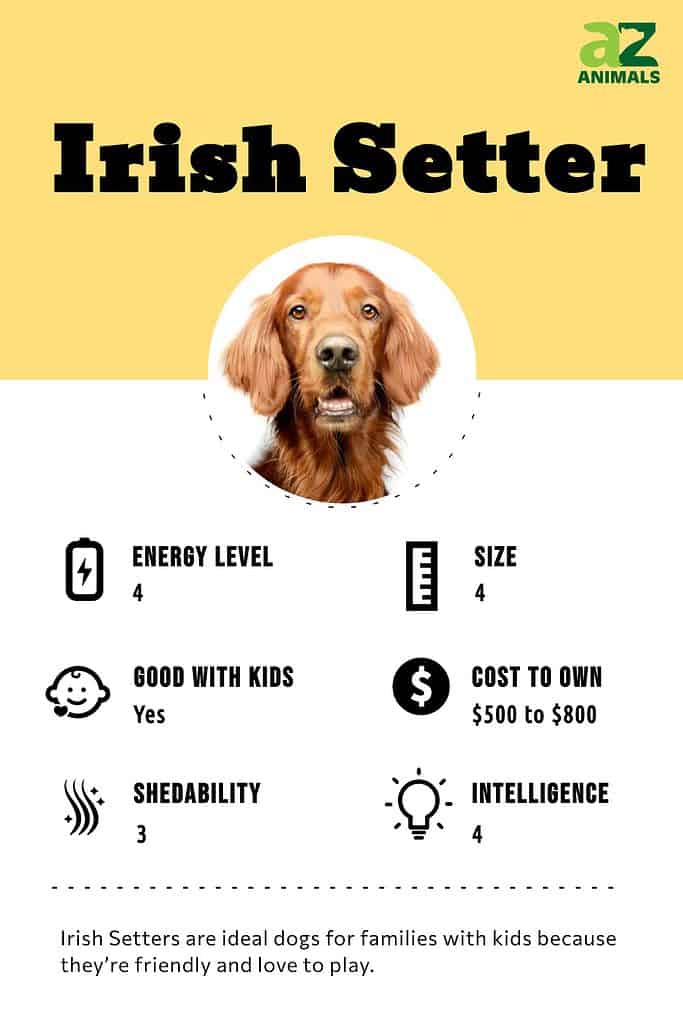
Known for their rich, silky, and mahogany or chestnut coats, Irish Setters are members of the sporting group of dogs. Their excellent sense of smell, persistence, and incredible speed have earned them a reputation as superb hunting dogs. They are popular as family pets due to their good nature, intelligence, and liveliness.
See all of our expert product reviews.
History and Origins
The Irish Setter originally descended from the Irish Red and White Setter, which was developed in the 18th century from a mix of the English Setter, Gordon Setter, Irish Terrier, Irish Water Spaniel, and Pointer. In Ireland in the 1800s, they were used as companions on hunting trips to track down birds in a field and other prey throughout the countryside.
Apart from a red and white coat, the Irish Red and White Setter has shorter legs than the Irish Setter, which assists the hunting dogs to “set” their game, crouching down low near it so the hunter can throw a net over both to complete the capture.
The Irish Setter was developed through selective breeding in the 19th century, which saw the white being removed from the coat and resulted in the solid chestnut red coat of Irish Setters today. Irish Setters became so dominant that by the end of the 19th century the Irish Red and White Setter was very rare, until the 1920s when the breed was revived.
The first Irish Setter in America was a dog named Elcho, who was imported in 1875. The breed, once known as the Irish Red Setter in the U.S., quickly became a favorite in the dog show ring. In the 1960s, the breed’s popularity grew further due to an Irish Setter being the star of the movie “Big Red.”
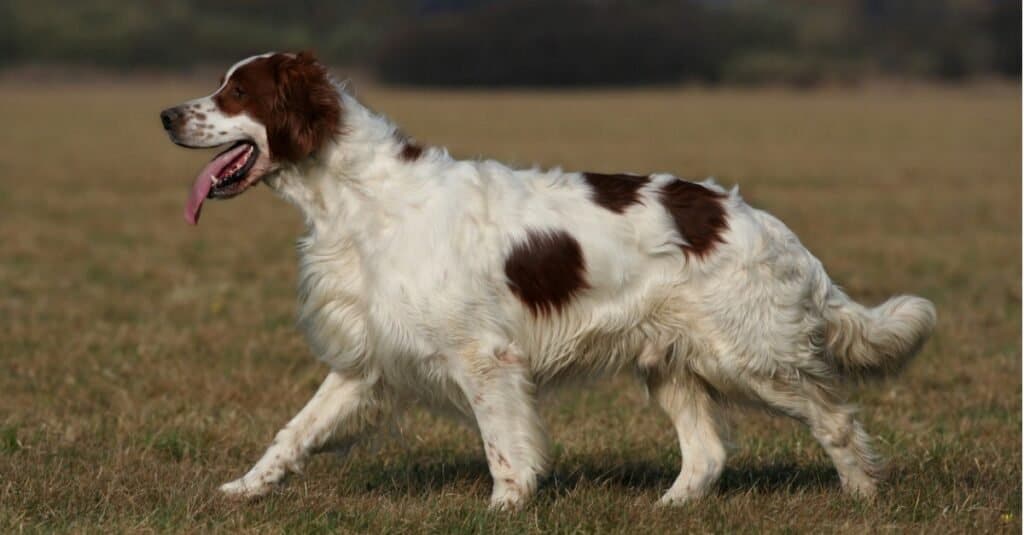
The Irish Setter was developed through selective breeding of the Irish Red and White Setter.
Health and Entertainment for your Irish Setter
See all of our expert product reviews.
©iStock.com/Wavetop
Types of Irish Setters
Irish Setters were so successful in the show ring that in 1940 the magazine “Field and Stream” raised concern about them disappearing from the field and losing their status as working dogs. This led to two types being developed: a show dog that had a larger and heavier body and a field dog that was lighter and sleeker.
The field dog, or working dog, weighs around 45 pounds on average, compared to the show dog, which can grow up to 70 pounds. The field Irish Setter has a less silky coat, shorter feathering, and lighter coloring of russet or fawn shades.

The Irish Setter is classified either as a show dog or a field dog.
©Kseniia Kolesnikova/Shutterstock.com
Owning an Irish Setter: 3 Pros and Cons
| Pros! | Cons! |
| Affectionate The breed is good-natured and generally affectionate with family, kids, and strangers. In addition, Irish Setters are normally well-behaved with other dogs. | Separation anxiety Irish Setters often suffer from separation anxiety when left at home for long periods. Crate training can create a more comfortable environment for setters while owners are away from the house. |
| Intelligent Irish Setters are incredibly intelligent dogs. This means the breed can be trained quickly, although it can be a challenge to keep their focus during this training! | High energy! Irish Setters love to run and get exercise! For this reason, it’s best to have a yard that can accommodate their need to run. |
| Their coat The Irish Setter has a beautiful coat that’s flowing and feathered. Many owners find this coat extremely charming and it has been a big factor in the rising popularity of the breed (although, as you’ll see in our “cons,” it also requires maintenance). | Grooming needs Irish Setters have long coats that can become matted and tangled. Caring for this coat requires frequent brushing and combing. Additionally, the dog’s beautiful coat also will lead to shedding. |
Size
Irish Setters are medium to large dogs. A male Irish Setter grows to be 27 inches tall at its shoulder while females measure 25 inches tall at the shoulder. In terms of weight, a male weighs from 60 to 71 pounds while a female weighs from 53 to 64 pounds.
At 8 weeks an Irish Setter should weigh 11 to 12 pounds. This dog reaches adulthood at 12 months of age.
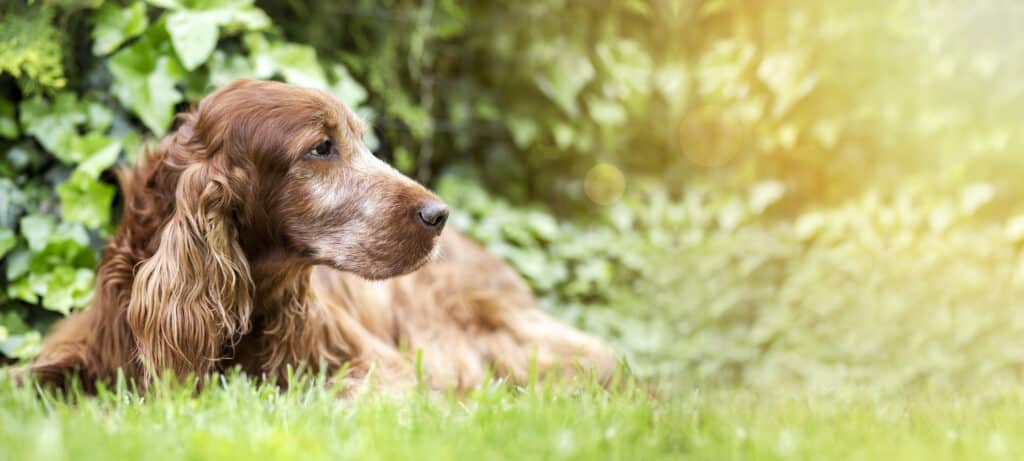
Irish Setters are medium to large dogs that can weigh up to 71 pounds.
©Reddogs/Shutterstock.com
Common Health Issues
One of the most common health issues of Irish Setters is known as hip dysplasia. Hip dysplasia causes weakness in the muscles and tissues of the hip joint. As this disease progresses it affects the walking and running motion of the dog. Excess weight can make this condition worse. Hypothyroidism is another common health issue for this breed of dog. It’s a decrease in normal thyroid levels that causes fatigue, weight gain, and skin issues including dry, scaly skin. Acral Lick Dermatitis is a common issue that causes an Irish Setter to continually lick and bite its skin/fur, especially on the lower body. This can be caused by anxiety or stress.
So, three of the most common health issues of Irish Setters include:
• Hip Dysplasia
• Hypothyroidism
• Acral Lick Dermatitis

Hypothyroidism is a common health issue for Irish Setters and causes fatigue, weight gain, and skin issues.
©Kseniia Kolesnikova/Shutterstock.com
Temperament
Irish Setters are ideal dogs for families with children because they’re loyal, energetic, and love to play. This is a dog with a friendly personality. Even after reaching adulthood, an Irish Setter still maintains a lot of the traits it had as a puppy. These dogs love to run, jump, chase, fetch, and have a romping good time!
Irish Setters are compatible with humans and mix well with other dogs. So, a trip to the dog park is a real treat. They are clever dogs with a loud bark that can alert a household of someone at the door or on the property. However, Irish Setters aren’t known to be guard dogs. While their barking can signal the presence of someone at the door, this dog’s behavior is likely to be affectionate and welcoming to friends and strangers alike.
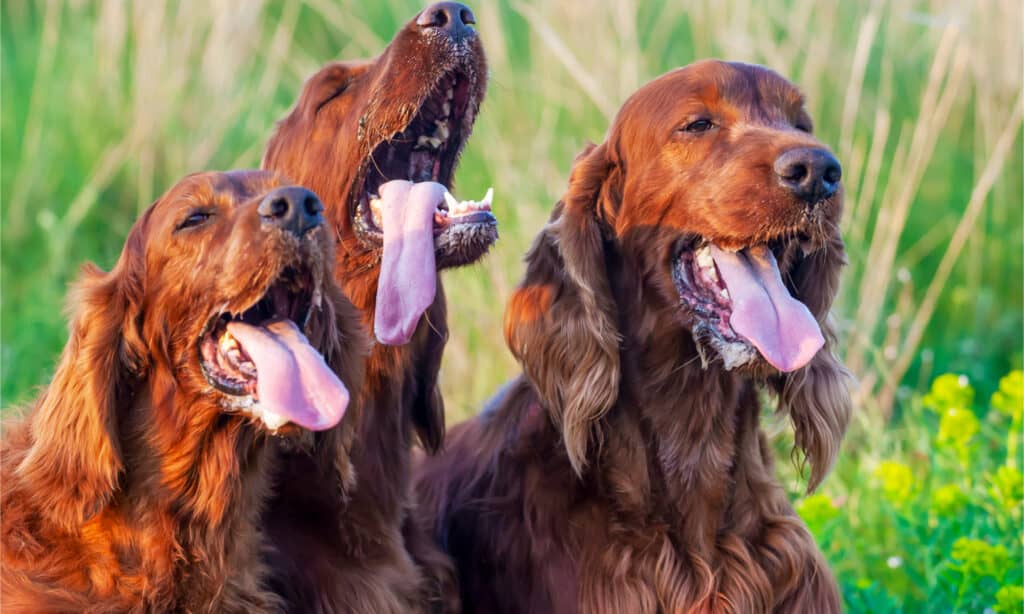
Irish Setters love to play and get along well with other dogs.
©Reddogs/Shutterstock.com
How to Take Care of an Irish Setter
Both Irish and English Setters have a medium to long-haired coat that needs regular grooming to keep it well-maintained. Also, whether you have a puppy or an adult dog, Irish Setters have a lot of energy and require regular exercise. The common health conditions of this pet including hip dysplasia, hypothyroidism, and Acral Lick Dermatitis must all be factored into the care of your Irish Setter.
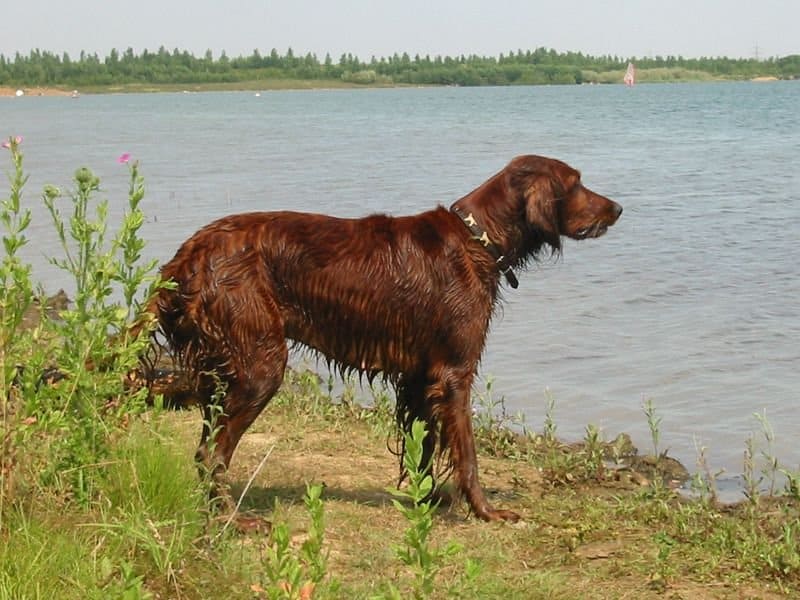
Irish Setters have a medium to long-haired coat that requires regular grooming.
©Daniel V / Creative Commons – Original
The Best Dog Food for Irish Setters
Irish Setters have different nutritional needs as puppies and as adult dogs. In fact, giving your Irish or English Setter the right type of food at the proper time can make all the difference in its health throughout its life.
Irish Setter puppy food: Dry food is an excellent option for puppies. Look for puppy food with increased amounts of calcium. Calcium strengthens developing bones which can help to prevent hip dysplasia in Irish Setters. Also, choose food with increased protein for muscle development. Giving your Irish Setter food that’s higher in calories is a good choice because your puppy is going to be very active. Omega-3 fatty acids support a puppy’s eye and brain development.
Irish Setter adult dog food: An adult Irish Setter should eat dog food with antioxidants that support the health of its immune system. A healthy immune system can help prevent hypothyroidism. Also, wheat is an important ingredient in food for an adult Irish Setter. It is a slow-digesting ingredient that gives an adult dog nutrition while preventing weight gain. Consider that food high in protein, as well as vitamins A, B6, and E, can contribute to a normally functioning thyroid and help maintain healthy skin. Plus, vitamin B6 is known to increase serotonin in the brain which can help to calm an anxious dog suffering from Acral Lick Dermatitis.
To satisfy their nutritional needs, A-Z Animals believes the best dog food for Irish Setters is Hill’s Science Diet Adult Large Breed Speciality Dry Dog Food.
Vets and animal nutritionists designed this formula just for big breeds, with an optimum protein and prebiotic fiber balance for healthy digestion. Plus, those vitamins A and E and omega fatty acids also promote healthy skin, and calcium contributes to strong bones and joints.
Check out Hill’s Science Diet Large Breed Dog Food on Chewy or Amazon.
Maintenance and Grooming
How much do Irish Setters shed? Irish Setters shed an average amount of hair which increases or decreases during different seasons throughout the year. This dog’s beautiful coat of long, fine hair requires grooming about three times a week to keep it in good condition. A slicker dog brush is a useful grooming tool that reaches down into your Irish Setter’s coat to remove tangles and loose hair. A slicker brush has individual plastic pins as bristles and is gentle on your dog’s skin while stirring up natural oils and creating shine.
Alternately, a brush with boar’s hair bristles is another good tool to have for your Irish Setter’s grooming routine. The bristles clear away tangles and remove dead hair from your dog’s coat. Be sure to work from your dog’s head toward its tail, brushing in the natural direction of its hair.
Check the ears once a week in order to clear away any excess wax or dirt. Use a soft cloth moistened with warm water to clear away any debris. This helps prevent ear infections.
Additionally, brush your dog’s teeth once a week to help prevent teeth and gum issues. Be sure to use toothpaste designed for dogs. Dental chews are a great option to help your pet maintain dental health.
A-Z Animals recommends this two-sided brush for grooming your Irish Setter.
- Dual-head design features 2 sides
- One side for smooth dematting and the other side quickly thins and desheds
- Skin-safe design won't scratch your pet
- Easy-grip handle is non-slip for a comfortable grip
- Includes a "paw tag" for your pet's collar or your keychain!
Training
Irish Setters can be somewhat challenging to train. They are energetic dogs that want to be moving around and active. This can make it tough to capture your Irish Setter’s attention and keep it. Once you have their attention, they are quick to learn obedience lessons. As a comparison, Golden Retrievers are energetic dogs as well, but they are easier to train because of their ability to focus on their owner.
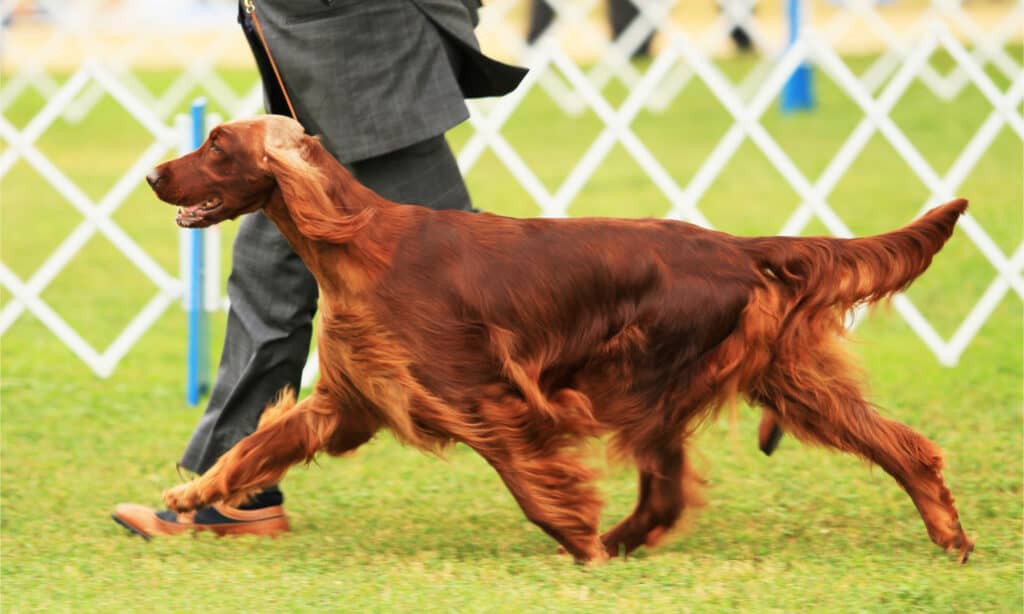
It can be difficult to maintain an Irish Setter’s attention but once you have it, they are fast to learn obedience.
©Canden Scales/Shutterstock.com
Exercise
Irish Setters are energetic dogs. This is true as well for their close relative the English Setter. Therefore, they need at least one hour of exercise each day to stay healthy. Exercise for an Irish Setter doesn’t mean walking on a leash. Ideally, this dog should have plenty of space in a home’s backyard, nearby field, or dog park to run around, jump, and bark.
So, an Irish Setter is not a good choice for owners who live in an apartment unless they’re dedicated to taking their dog to an open space to run around for at least an hour each day. An Irish Setter that doesn’t get enough exercise can develop health issues including excess weight and hypothyroidism.
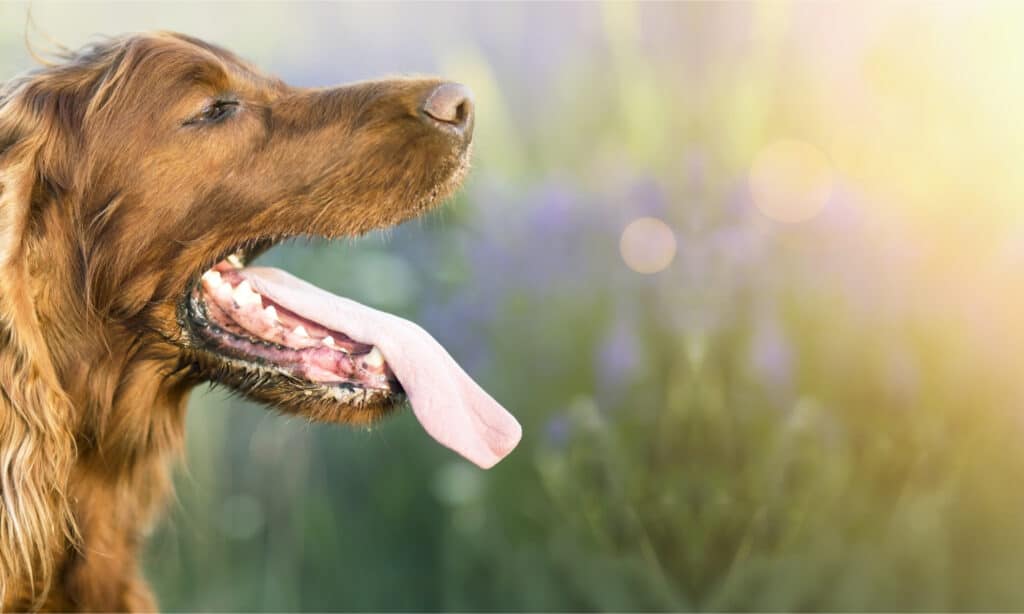
Irish Setters need at least one hour of exercise daily to maintain good health.
©Reddogs/Shutterstock.com
Puppies
Irish Setter puppies are easy to housetrain if you have a consistent routine. Take your puppy outside at the same times, to the same area to relieve itself throughout the day.
They need exercise just as much as adult dogs do. So, be sure to allow your puppy to exercise in an enclosed area until it has learned obedience commands such as come and stay. You want to make sure your puppy is safe while it’s getting exercise.
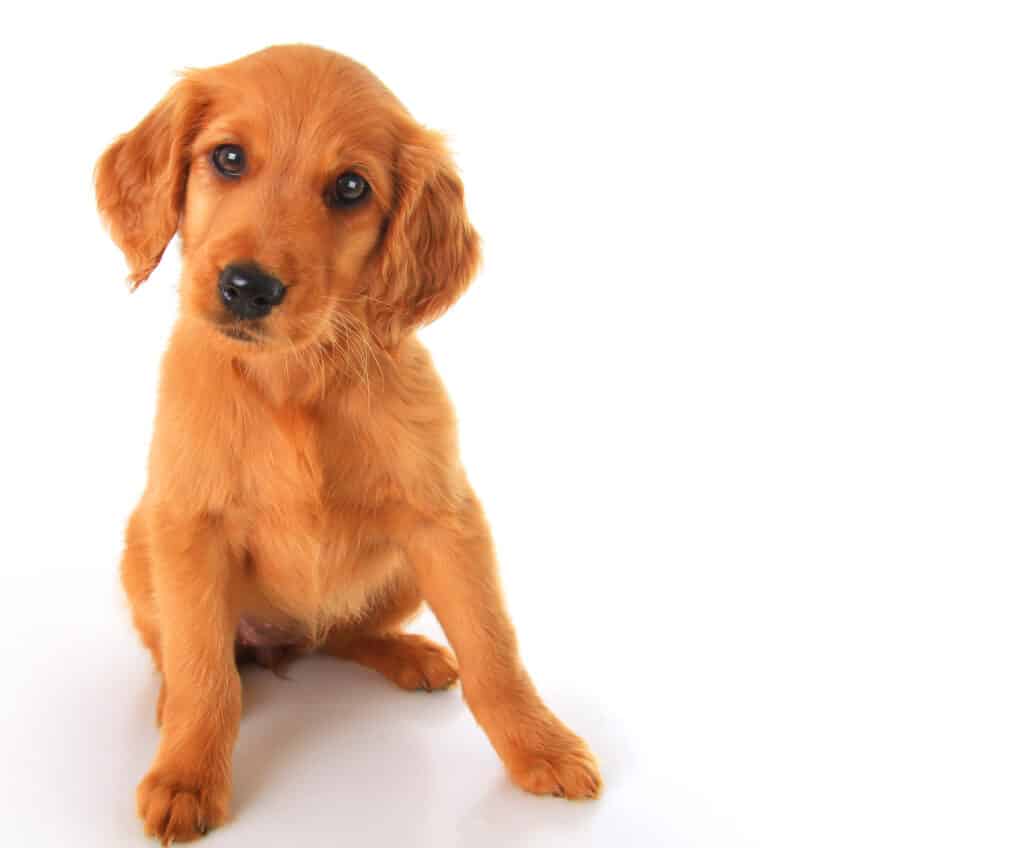
If you establish a consistent routine, puppies are easy to house-train.
©Hannamariah/Shutterstock.com
Irish Setters and Children
Irish Setters are good dogs for families with children. Their temperament is a wonderful mix of playfulness and affection. Also, keep in mind that these dogs grow to be 60 to 70 pounds so they should be monitored while playing with toddlers or small children. Sometimes these dogs get very excited and may accidentally knock over a child in all the fun!
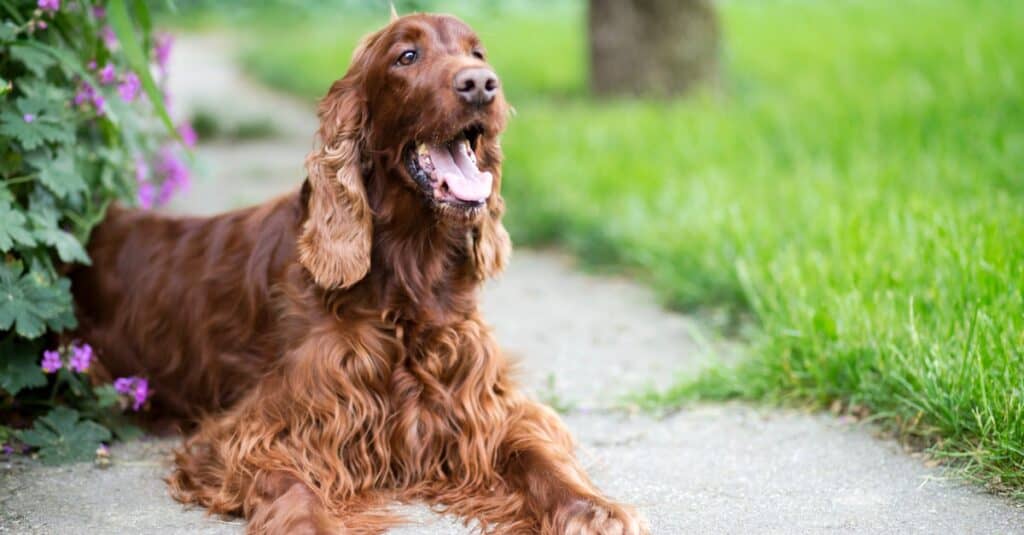
The Irish Setter has a playful and loving temperament.
©iStock.com/Wavetop
Dogs Similar to Irish Setters
There are a few dog breeds similar to the Irish Setter. The Golden Retriever, the Labrador Retriever, and the Chesapeake Bay Retriever are all examples.
• Golden Retriever: Golden Retrievers share several traits with Irish Setters including a friendly, affectionate temperament. They are both energetic, family dogs.
• Labrador Retriever: Labrador Retrievers and Irish Setters grow to be about the same size. Plus, they are both sporting dogs taken on hunting trips to track down prey.
• Chesapeake Bay Retriever: This is another high-energy dog. They are taken as companions on hunting trips and are members of the sporting group.
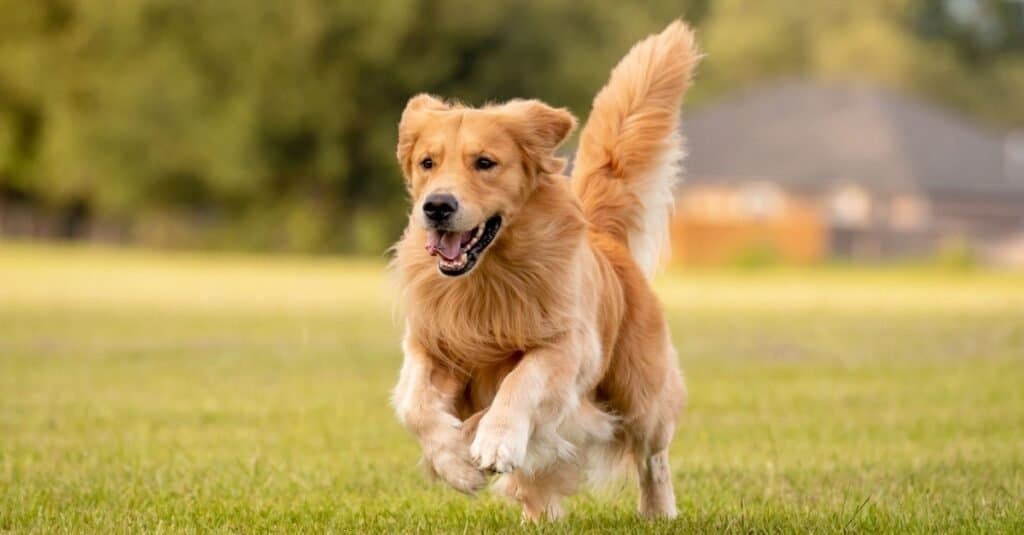
Golden Retrievers and Irish Setters are both energetic dogs suitable for families.
©iStock.com/Tatyana Consaul
Popular Names for Irish Setters
Some of the most popular names for Irish Setters:
• Rusty
• Red
• Beau
• Bruno
• Samson
• Pepper
• Penny
• Honey
• Gracie
Famous Irish Setters
There have been many famous Irish setters throughout history including:
- Elcho: One of the first Irish Setters to move stateside and a championship-level dog. Elcho produced nearly 200 puppies in the 1870s and helped establish the popularity of the breed.
- King Tomahoe: One of Richard Nixon’s most beloved pets. This Irish Setter was often called “Tom” for short.
- Peggy: An Irish Setter that was the pet of Ronald Reagan.
- Mike: The Irish Setter that occupied the White House during Harry Truman’s time as President.
That’s right, during the 20th century three different Presidents had Irish Setters!
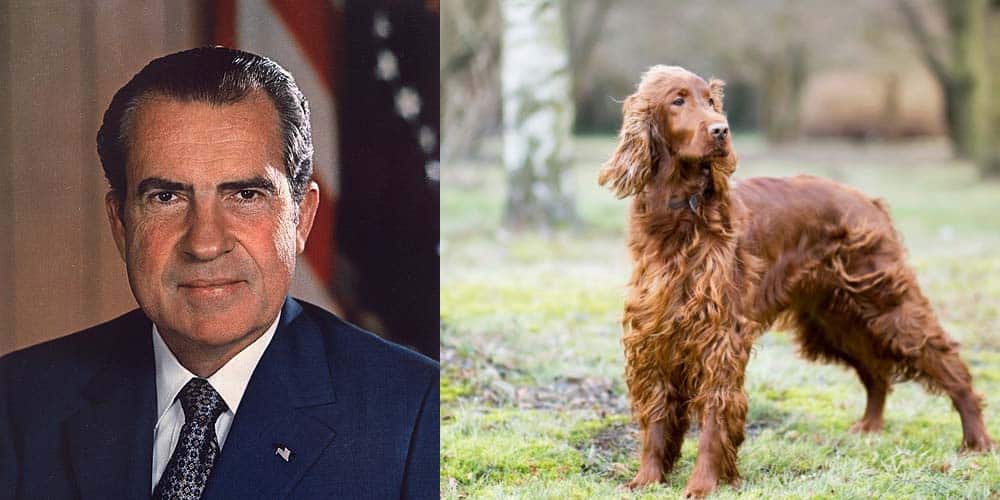
Irish Setter FAQs (Frequently Asked Questions)
How much does it cost to own an Irish Setter?
The initial price of an Irish Setter ranges from $500 to $800. Sometimes these puppies cost more than $800 if they’re purebred with an excellent pedigree. It’s a smart idea to call your local animal shelter to see if they have an Irish Setter or Irish Setter mix available for adoption. Adopting a dog is much less expensive than buying from a breeder.
Yearly basic veterinary costs for an Irish Setter are around $300. Of course, if your pet has any health issues that number could go up.
You’re likely to spend around $100 a month on dog food for your Irish Setter. This cost varies depending on the brand of dog food you purchase and how much your pet eats.
Are Irish Setters good with kids?
Yes, Irish Setters are good with kids. They are playful and like to participate in running and field games. The kids in a family will never have to convince an Irish Setter to join in the fun!
How long do Irish Setters live?
The lifespan of an Irish Setter runs from 12 to 15 years. Of course, an Irish Setter can live longer than 15 years depending on its overall health and genetics.
Are Irish Setters good family dogs?
Yes, Irish Setters make good family dogs whether a family has teenagers, young children, or no children. One thing to remember is these dogs like companionship. In short, they don’t like to be left alone for long periods of time. If a family has two Irish Setters it makes it easier on these dogs when family members leave for the day.
Do Irish Setters shed a lot?
Irish Setters shed an average amount of hair. They shed more hair in the spring and fall than in other seasons. But, with regular grooming, an owner doesn’t have to deal with a lot of dog hair left behind on the furniture.
What is the difference between an Irish Setter and a Red Setter?
Irish Setters and Red Setters are similar in that they both have a red coat. However, there are a few differences. Size is one of the main differences between these dogs. A Red Setter is smaller than an Irish Setter and has a different stance when tracking prey on a hunting trip. An Irish Setter with its shiny coat of long, red hair is more in the category of a show dog. Alternatively, a Red Setter’s coat is a little duller in color and it’s known more as a field dog than a show dog.
Though these dogs have a few differences, they are both friendly, energetic pets that would be happy in a welcoming home with a big yard to play in!
Are Irish Setters herbivores, carnivores, or omnivores?
Irish Setters are Omnivores, meaning they eat both plants and other animals.
What Kingdom do Irish Setters belong to?
Irish Setters belong to the Kingdom Animalia.
What class do Irish Setters belong to?
Irish Setters belong to the class Mammalia.
What phylum to Irish Setters belong to?
Irish Setters belong to the phylum Chordata.
What family do Irish Setters belong to?
Irish Setters belong to the family Canidae.
What order do Irish Setters belong to?
Irish Setters belong to the order Carnivora.
What genus do Irish Setters belong to?
Irish Setters belong to the genus Canis.
What type of covering do Irish Setters have?
Irish Setters are covered in Hair.
What is an interesting fact about Irish Setters?
Irish Setters can live for up to 15 years!
What is the scientific name for the Irish Setter?
The scientific name for the Irish Setter is Canis Lupus.
What's the difference between Irish Setters and Golden Retrievers?
Golden Retrievers live shorter lives than Irish Setters. The Irish Setter has longer ears than the average Golden Retriever, and Golden Retrievers are considered more laid-back than the excitable Irish Setter.
What's the difference between Irish Setters and English Setters?
Irish Setters come in fewer colors compared to English Setters. Additionally, Irish Setters live slightly longer lives compared to English Setters.
Thank you for reading! Have some feedback for us? Contact the AZ Animals editorial team.
Sources
- David Burnie, Dorling Kindersley (2011) Animal, The Definitive Visual Guide To The World's Wildlife / Accessed November 11, 2008
- Tom Jackson, Lorenz Books (2007) The World Encyclopedia Of Animals / Accessed November 11, 2008
- David Burnie, Kingfisher (2011) The Kingfisher Animal Encyclopedia / Accessed November 11, 2008
- Richard Mackay, University of California Press (2009) The Atlas Of Endangered Species / Accessed November 11, 2008
- David Burnie, Dorling Kindersley (2008) Illustrated Encyclopedia Of Animals / Accessed November 11, 2008
- Dorling Kindersley (2006) Dorling Kindersley Encyclopedia Of Animals / Accessed November 11, 2008
- (1970) http://www.vetstreet.com/dogs/irish-setter Jump to top

